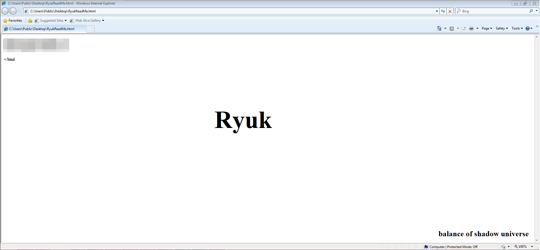Ransom.Win32.RYUK.SMTH1
Ransom:Win64/Ryuk.PA!MTB (Microsoft); GenericRXGP-NG!85501B7C500A (McAfee); Trojan-Ransom.Win32.Cryptor.cmr (Kaspersky); Troj/Ransom-FAF (Sophos)
Windows


Threat Type: Ransomware
Destructiveness: No
Encrypted:
In the wild: Yes
OVERVIEW
Dropped by other malware, Downloaded from the Internet
This Ransomware arrives on a system as a file dropped by other malware or as a file downloaded unknowingly by users when visiting malicious sites.
It drops files as ransom note.
TECHNICAL DETAILS
180,224 bytes
EXE
Yes
05 Aug 2019
Terminates processes, Displays windows, Encrypts files
Arrival Details
This Ransomware arrives on a system as a file dropped by other malware or as a file downloaded unknowingly by users when visiting malicious sites.
Installation
This Ransomware drops the following files:
- %Public%\sys
- {Encrypted Folder}\RyukReadMe.html
(Note: %Public% is the folder that serves as a repository of files or folders common to all users, which is usually C:\Users\Public in Windows Vista, 7, and 8.)
Process Termination
This Ransomware terminates the following services if found on the affected system:
- back
- xchange
- ackup
- acronis
- sql
- enterprise
- sophos
- veeam
- acrsch
- antivirus
- bedbg
- dcagent
- epsecurity
- epupdate
- eraser
- esgshkernel
- fa_scheduler
- iisadmin
- imap4
- mbam
- endpoint
- afee
- mcshield
- task
- mfemms
- mfevtp
- mms
- msdts
- exchange
- ntrt
- pdvf
- pop3
- report
- resvc
- sacsvr
- savadmin
- sams
- sdrsvc
- sepmaster
- monitor
- smcinst
- smcservice
- smtp
- snac
- swi_
- ccsf
- truekey
- tmlisten
- ui0detect
- w3s
- wrsvc
- netmsmq
- ekrn
- ehttpsrv
- eshasrv
- avp
- klnagent
- wbengine
- kavf
- mfefire
It terminates the following processes if found running in the affected system's memory:
- backup
- xchange
- sql
- dbeng
- sofos
- calc
- ekrn
- zoolz
- encsvc
- excel
- firefoxconfig
- infopath
- msaccess
- mspub
- mydesktop
- ocautoupds
- ocomm
- ocssd
- onenote
- oracle
- outlook
- powerpnt
- sqbcoreservice
- steam
- synctime
- tbirdconfig
- thebat
- thunderbird
- visio
- word
- xfssvccon
- tmlisten
- pccntmon
- cntaosmgr
- ntrtscan
- mbamtray
Other Details
This Ransomware does the following:
- Injects to all running processes except for the following:
- explorer.exe
- csrss.exe
- lsaas.exe
- {Malware Filename}.exe
Ransomware Routine
This Ransomware renames encrypted files using the following names:
- {encrypted file}.RYK
It appends the following extension to the file name of the encrypted files:
- {Encrypted Director}\{Encrypted Filename}.RYUK
It drops the following file(s) as ransom note:
- {Encrypted folder]\RyukReadMe.html

SOLUTION
9.850
15.208.08
01 Jul 2019
15.209.00
02 Jul 2019
Step 1
Trend Micro products with the XGen technology detect this malware as
Step 2
Before doing any scans, Windows 7, Windows 8, Windows 8.1, and Windows 10 users must disable System Restore to allow full scanning of their computers.
Step 3
Note that not all files, folders, and registry keys and entries are installed on your computer during this malware's/spyware's/grayware's execution. This may be due to incomplete installation or other operating system conditions. If you do not find the same files/folders/registry information, please proceed to the next step.
Step 4
Restart in Safe Mode
Step 5
Identify and terminate files detected as Ransom.Win32.RYUK.SMTH1
- Windows Task Manager may not display all running processes. In this case, please use a third-party process viewer, preferably Process Explorer, to terminate the malware/grayware/spyware file. You may download the said tool here.
- If the detected file is displayed in either Windows Task Manager or Process Explorer but you cannot delete it, restart your computer in safe mode. To do this, refer to this link for the complete steps.
- If the detected file is not displayed in either Windows Task Manager or Process Explorer, continue doing the next steps.
Step 6
Search and delete these files
- %Public%\sys
- {Encrypted Folder}\RyukReadMe.html
Step 7
Restart in normal mode and scan your computer with your Trend Micro product for files detected as Ransom.Win32.RYUK.SMTH1. If the detected files have already been cleaned, deleted, or quarantined by your Trend Micro product, no further step is required. You may opt to simply delete the quarantined files. Please check this Knowledge Base page for more information.
Step 8
Restore encrypted files from backup.
Step 9
Scan your computer with your Trend Micro product to delete files detected as Ransom.Win32.RYUK.SMTH1. If the detected files have already been cleaned, deleted, or quarantined by your Trend Micro product, no further step is required. You may opt to simply delete the quarantined files. Please check the following Trend Micro Support pages for more information:
Did this description help? Tell us how we did.

